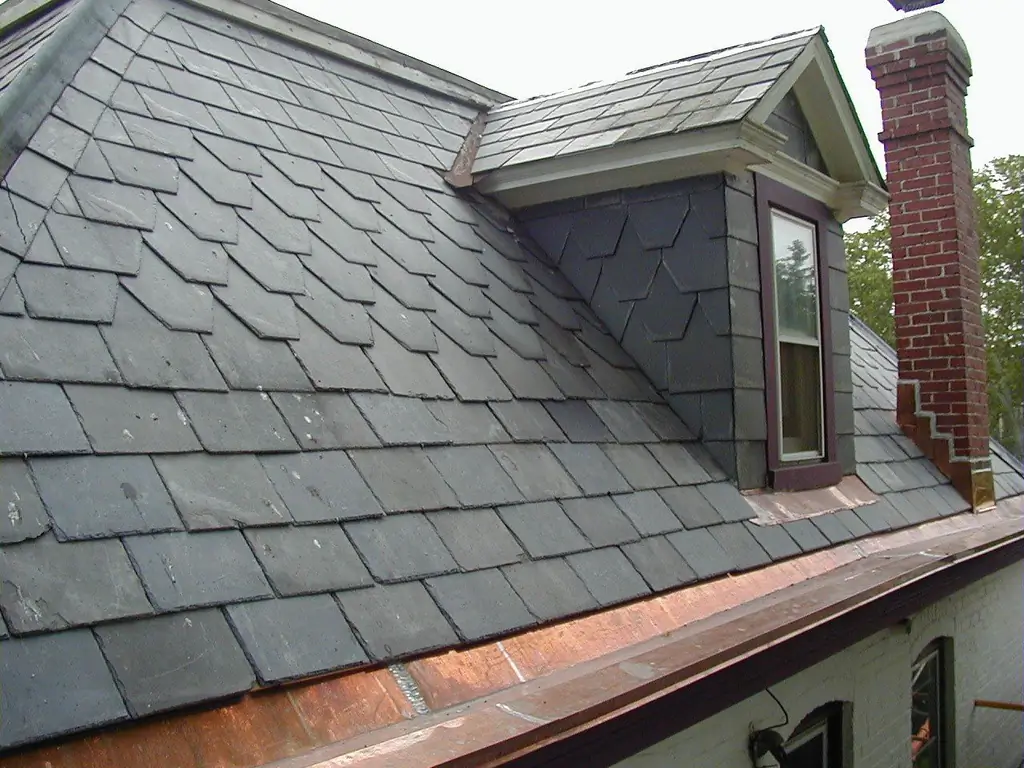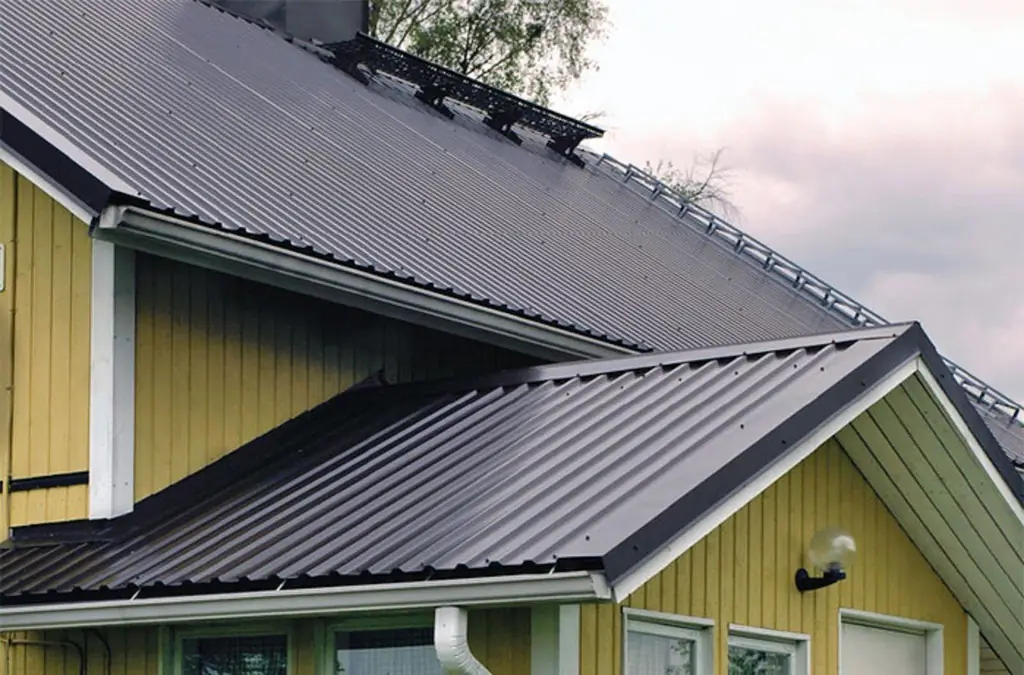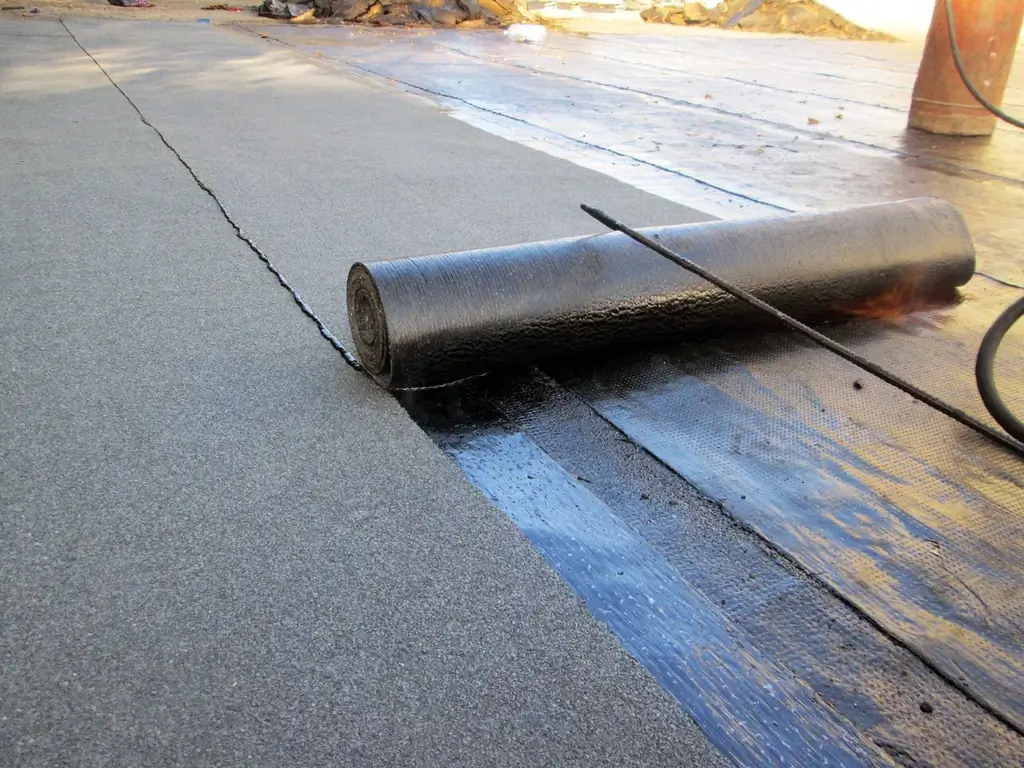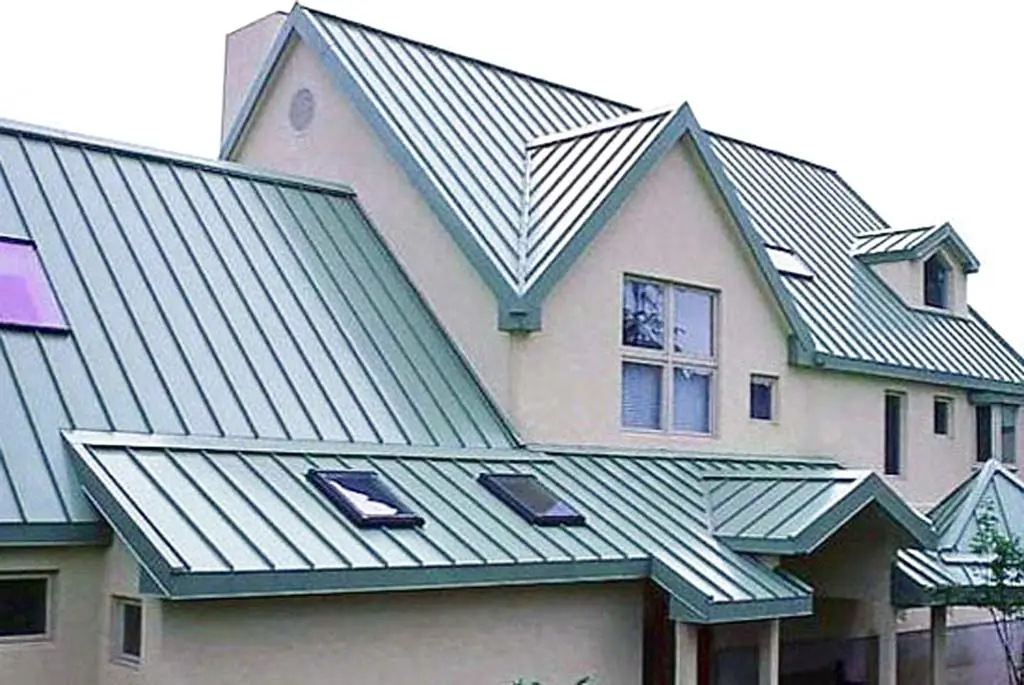
Table of contents:
- All about slate roofing: design, operation, installation
- Slate roofs - material features, installation and operation
- Features and characteristics of slate for roofs
- Slate roofing tool
- Slate roofing device
- Features of installing a slate roof
- Typical mistakes when installing a slate roof
- Features of the operation of a slate roof
- Author Bailey Albertson [email protected].
- Public 2024-01-17 22:26.
- Last modified 2025-06-01 07:32.
All about slate roofing: design, operation, installation

Roofs made of clay shale are one of the oldest ways to protect a home. Nevertheless, this covering material is still relevant, since it has an almost unlimited service life. Having carefully studied the theoretical provisions, the roofs of simple forms can be done by hand.
Content
-
1 Slate roofs - material features, installation and operation
1.1 Photo gallery: elite slate roofs
-
2 Features and characteristics of slate for roofs
2.1 Major manufacturers of roofing slate
-
3 Tool for slate roofing
3.1 Photo Gallery: Slate Tile Tool
- 4 Slate roofing
-
5 Features of installing a slate roof
- 5.1 English way
- 5.2 German way
- 5.3 French way
-
5.4 Rules for installing slate tiles
5.4.1 Video: how to install slate tiles
-
6 Typical mistakes when installing a slate roof
6.1 Video: installation of slate tiles
-
7 Features of the operation of a slate roof
- 7.1 Service life of slate roofing
- 7.2 Repair of slate roofing
Slate roofs - material features, installation and operation
Slate is one of the varieties of natural natural stone with unique properties. One of its features is the ability to split into thin plates, since the stone has a pronounced layered structure. Possessing high strength characteristics, this material has been used for roofing for many centuries. Many buildings with slate roofs are intact to this day, attracting the attention they deserve.
The ability to give the structure an original appearance and noble design have led to a sharp rise in the popularity of slate for roofing both in Europe and in Russia. Roofs made of this natural material are also an indicator of the status and material wealth of the owner, since the price per square meter of slate stone reaches 150 euros.
Photo gallery: elite slate roofs
-

Slate Tile Roof - Slate allows you to make roofs of any complexity
-

Green slate roof - Colored slate can be used to build a beautiful roof
-

Original slate roofing solution - Elite hut can be built with a slate roof
-

Slate roof with unusual shape -
Slate stone can be installed on complex roofs
-

House with slate roof - Interspersed mica makes the roof luminous
-

Ornamental slate roof - The small size of the slate tile allows you to lay out various patterns
-

Slate masonry - There are different types of slate masonry
-

Wooden house with slate roof - Slate roofing will add beauty and originality to any structure
Features and characteristics of slate for roofs
Natural building stone, split into 4-9 millimeter thick plates of various shapes, can be placed on roofs of any configuration. It is often not possible to cover such roofs with other materials.

An elite roof can be made of natural material - clay shale
Shale is characterized by good machinability, which makes it possible to obtain plates of the correct geometric shape, as well as to easily adjust individual parts at their place of installation.

Slate is the most durable material for roofs
Slate roofing tiles do not have a wide range of colors, the main ones are:
- the black;
- Gray;
- brown;
- green.
Slate interspersed with mica gives the visual effect of the luminosity of the roof. But such material is quite rare and is used mainly for finishing works of limited formats. The price for this unique material is several times higher than for ordinary slate, although it is not cheap either.

For roofs, gray slate is most often used.
The popularity of roofing slate is due to many positive qualities, among which the following properties are distinguished:
- No one can name the service life of slate roofing materials; it can stand on roofs for centuries, as evidenced by the presence in Europe of many old buildings with such coatings.
- Resistance to ultraviolet radiation allows you to keep the color of the material throughout the entire life of the roof.
- Natural stone does not emit any harmful radiation or substances.
- Slate materials are excellently processed and easily tolerate nailing without breaking.
- Roofs made of these materials are low-noise both in rain and hail, without creating uncomfortable conditions.
- Shale stone tolerates temperature fluctuations well over a wide range.
-
The material is absolutely fireproof, does not support combustion.

Slate roof Slate roof will last a very long time
The disadvantages include only two points - the high cost and significant weight of the slate roofing material. One square metro can weigh up to 50 kilograms.
Major manufacturers of roofing slate
European builders have long used this material for roofing. Therefore, all shale deposits are largely depleted. Since only deep-seated shales are used for this purpose, the production cost is very high and the volumes are limited. Roofing material of our own production is mined for restoration work on a special order from the state.
The leading companies in the German space are:
-
Primero-Schiefer;

Slate roofing Primero-Schiefer with ornament Slate from the German company Primero-Schiefer is a prestigious roofing material designed to create the most beautiful and durable roofs
- Jochann & Backes Schiefer;
-
Thies-Boger;

Slate roofing Thies-Boer Theis-Boger roof slate offers several types of masonry
-
VTS Koop Schiefer GmbH & Thüringen KG;

Turinger Schiefer roof slate VTS Koop Schiefer GmbH & Thuringen KG produces a comprehensive range of roofing and cladding slate templates
-
Magog Schiefer.

Magog Schiefer roof Magog Schiefer uses natural material from Bad Fredeburg
It should be noted that the main deposits of roofing slate in Europe are located in Spain and account for up to 90% of production. In addition, oil shale deposits are exploited in a quarry, which greatly affects the cost of the material in the direction of its reduction. Leading Spanish companies on the market:
- CUPA;
- Richter - Pizzaras;
-
Hispanica State.

Oil shale mining Roofing slate is quarried
In Russia, the production of slate roofing materials is concentrated at the Orion enterprise. Shale is also produced in Great Britain, Brazil and China.
Slate roofing tool
The peculiarity of the roof material gave rise to the original tools for working with it. The main ones are:
- Shale hammer. Designed to fit tiles on site. In addition, it can be used to make holes for nails.
- Shale anvil. It has several surfaces of different curvature. Used in conjunction with a hammer for the same purpose. It weighs about 600 grams.
- Crowbar. It is used when it is necessary to replace individual tiles.
- Cutter. It can be used to cut slate tiles. Equipped with a mount for installation directly on the roof.
- Tongs for cutting curly elements during installation of the roof.
- Bulgarian. It can be used to process slate tiles, but craftsmen use it reluctantly and only for rough work.
And also during the installation of roofs, stairs, stepladders, scaffolding, roof ladders and various types of insurance are used.
Photo Gallery: Slate Roofing Tool
-

Slate tongs - Tongs ensure a precise fit of tiles
-

Cutter - The cutter is applied at the installation site
-

Shale hammer - The purpose of the slate hammer is to adjust the tiles and fix them
-

Mount - A pry bar can remove tiles without damage
Slate roofing device
The peculiarity of the device of the rafter system for a slate roof is determined by its large weight. The roof skeleton must have increased strength. In this case, it is recommended to arrange the rafter pitch approximately 0.8-1.0 meters. For the section of the rafter, 50x150 millimeters are enough.
Similar requirements apply to slate lathing. It needs to be arranged as a continuous sheet of sheet materials, for example, plywood with a thickness of at least 20 millimeters. Fastening is done with screws about 100 mm long with a step of 150-200 mm. It is also allowed to use a grooved floor board with dimensions of 30x150 millimeters.
For the device of reliable under-roof ventilation, a counter-lattice of 50x50 mm bars is used in combination with a membrane film.
The insulating roofing cake is mounted from the inside of the roof using standard technology . All parts of the rafter system must be treated with fire retardants and antibacterial impregnations.

The tile must be installed on a solid crate
Fastening of slate roof tiles to the lathing is done with copper nails.
Features of installing a slate roof
Tiles are laid on a wooden base from the bottom corner of the roofing platform in one of three ways:
- English;
- German;
- French.
For each of them, tiles of various shapes are used.
English way
With this installation, rectangular tiles are used.

The English method uses rectangular tiles.
The maximum possible angle of inclination in the English method is 22 degrees. The tiles are laid from bottom to top with overlap of the vertical joint. Fastening is done with nails or special copper hooks.

You can fix the tiles with nails or staples.
The amount of overlap and side clearance during laying is from 30 to 60 millimeters.
German way
For this method, rectangular tiles with rounded corners are used. They are laid on the crate, fastening is done with nails. German slate tiles are used for tilt angles up to 25 degrees.

The use of the German installation method gives a "scale" pattern on the roof
The amount of overlap during installation is determined by the master roofer. The laying direction can be from left to right or vice versa, depending on which corner the installation is started from. The choice of angle depends on the prevailing direction of the winds, the beginning is the leeward angle.

When laying tiles, the direction of the blowing winds is taken into account
French way
This arrangement is used with square tiles with cut corners that are oriented vertically.

At the intersection of the slopes, the tiles are laid in the French way
Fastening the tiles to the deck is done with 2-3 nails each, depending on the size of the tiles and the slope.

Tiles are attached to the crate with nails
For any installation method, start from the gutter using larger tiles. As you get closer to the ridge of the roof, the tile size decreases. On the line of the ridge transition, the tiles are installed with an excess of 4-6 cm over the other slope. At the end of the laying, this gap is sealed with a cement-based sealing mortar.
When decorating chimneys or turrets, rectangular tiles are used - 16x22 cm scales.
Slate tile installation rules
-
Before starting the installation, the slate tiles must be sorted by thickness to avoid gaps if thick tiles lie on top of thin tiles.

Preparation for laying a slate roof Plates are distributed in thickness
- Before installing the tile in place, it must be checked for integrity. This is done by gently tapping it with a hammer. In this case, the sound should be sonorous, metallic. If it is deaf or rattling, there is a crack in the part. In the future, it can be used after trimming and re-checking.
- The installation of the roofing can only be started after the completion of the tin and carpentry work, the placement of antennas, plates and lightning rods. In this order, damage to the coating as a result of movement over it is excluded.
- The correct direction of the masonry depends on the prevailing wind direction in the region and is laid down at the stage of building construction. If it is not selected correctly, roof leaks may occur.
-
Fixation of each part is done with two nails, for which holes have already been made in the tiles. The exception is made by the details of the extreme rows at the transitions, experiencing increased loads. When installing them, an additional third hole is drilled.

Fixing tiles with nails There must be a gap between the tile and the nail head.
- When installing a slate roof, copper or galvanized nails are used. When installing them, it is impossible to hammer nails “into tightness”, temperature fluctuations of the coating and shrinkage of the ladder wood create additional stresses in the tiles, which can lead to the formation of cracks and disruption of the continuity of the coating.
Video: how to install slate tiles
Typical mistakes when installing a slate roof
The manufacture of roofs of this type requires special care. The most common errors of this kind are:
- Insufficient personnel training. In Europe, oil shale roofers undergo special training for 2-4 years.
- Constructive errors in the development of the roof project, for example, the laying of slopes of less than 22 degrees or poor-quality study of the execution of joints.
- Poorly executed heat and waterproofing of the roof, which leads to wetting of the parts of the rafter system and its accelerated deterioration.
- Moving workers on a slate roof without using ladders will inevitably lead to its deterioration - the formation of numerous cracks that may appear during operation. Such personnel must be said goodbye immediately after the first violation.
- Slabs are not sorted by thickness. As a result, leaks are inevitable in certain wind directions.
- The quality of the material. In a batch of slate tiles, all material must be of the same quality. Therefore, when purchasing, you must require the provision of a certificate and test reports.
There is a belief that leaks on a slate roof are inevitable, and the tightness is ensured by waterproofing. But in Europe there are many buildings that are two hundred years old with slate roofs on wooden lathing. At that time they had no idea about waterproofing, and the roofs work to this day and without leaks.
Video: installation of slate tiles
Features of the operation of a slate roof
Roofs of this type require increased attention, especially in the first years of operation.
Slate roof service life
The operating time of slate roofs has not been established, but the account can go on for centuries. Natural stone practically does not wear out. If the rafter system is made with high quality, the roof will serve for a long time and reliably. An example is old buildings in Europe.
Slate roof repair
Speaking about the durability of slate roofs, it should be borne in mind that such a roof needs maintenance, like any other structure. It consists of the following:
- Regular inspection of the condition of the roof and rafter system. In the case of slate roofs, it is better to conclude a service contract with a professional organization. Proper and timely maintenance will help extend the life of the roof and prevent significant damage.
-
If it is necessary to repair with the replacement of individual tiles, a specialized tool is used, which cannot be on the owner's farm. Roofing silicone sealant can be used to repair minor damage and cracks.

Slate roof repair Damaged tiles can be replaced with new ones
- In the first few years after installing a slate roof, several tiles may break and need to be replaced. This should not be attributed to poor quality material or workmanship. The reason may be the operational characteristics of the building.
Despite the high cost of the material and work on the installation of slate roofs, they continue to gain popularity in the roofing market.
Slate tile roofs are the most sophisticated devices of their kind. The high installation costs are offset by an almost unlimited lifetime. In addition, such roofs are recognized as elite in terms of beauty and the possibility of installation on non-standard objects. Such structures can only be done by professionals.
Recommended:
Roofing From A Profiled Sheet, Including The Features Of Its Design And Operation, Repair, As Well As How To Avoid Mistakes During Installation

What kind of profiled sheet can be used for the roof. DIY cold and insulated roof device. What mistakes are possible. Features of operation and repair
Polycarbonate Roofing, Including The Features Of Its Construction, Operation And Repair, As Well As How To Avoid Mistakes During Installation

Characteristics of polycarbonate as a roofing material. How to make a polycarbonate roof with your own hands. Features of operation and repair. Photo and video
Roll Roofing, Including The Features Of Its Construction, Operation And Repair, As Well As How To Avoid Mistakes During Installation

The difference between roll roofing and modern and Soviet counterparts. Can I use roll roofing on a pitched roof? How to install it and when to repair it
Roofing Made Of Corrugated Board, Including The Features Of Its Design And Operation, Repair, As Well As How To Avoid Mistakes During Installation

Features and characteristics of corrugated roofing. Types of roofing sheeting. Calculation of the amount of material for the roof. Features of installation and operation
Seam Roofing, Including The Features Of Its Construction, Operation And Repair, As Well As How To Avoid Mistakes During Installation

Features of the design and characteristics of the folded roof. Required tools and installation sequence. Repair and operation of seam roofing
